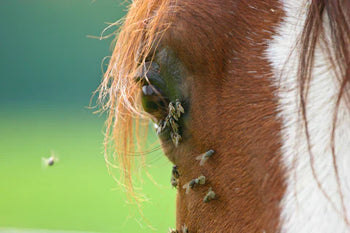

Table of contents
Respiratory Condition In Horses - Heaves (SPARAO)
This summer Respiratory Condition In Horses is one of the most significant chronic respiratory conditions affecting horses. While it can occur year round, a seasonal variation known as Summer Pasture-Associated Recurrent Airway Obstruction presents challenges during warmer months.
NAF offers a range of products helping you to supporting respiratory health in horses includes a condition called Summer Pasture-Associated Recurrent Airway Obstruction (SPARAO), often referred to as “heaves” or equine asthma.
As an official stockist for NAF we aim to help you understand this respiratory conditionin horses, allowing us to support our customers with effective advice and relevant solutions
What is SPARAO? Summer Pasture - Associated Recurrent Airway Obstruction also known at Heaves
SPARAO is a summer respiratory condition in horses triggered by increased exposure to allergens commonly found in pastureenvironments during spring and summer. These include pollen from grasses and trees,airborne mould spores, and dust, all of which can cause hypersensitive reactions inaffected horses.
This respiratory condition in horses is an immune overreaction results in inflammation, narrowing of theairways (bronchoconstriction), and mucus production, compromising the horse’sability to breathe effectively.
Heaves, also known as Recurrent Airway Obstruction (RAO) or Chronic Obstructive Pulmonary Disease (COPD) in horses, is a respiratory condition similar to asthma in humans. It's one of the most common respiratory diseases affecting horses, particularly those over 7 years old.
The condition is characterized by inflammation and constriction of the small airways in the lungs, making it difficult for horses to breathe normally. Horses with heaves typically develop a characteristic "heave line" - a visible groove along the lower chest and abdomen from the extra effort required to exhale.
Recognising The Signs Of Heaves - SPARAO Summer Pasture - Associated Recurrent Airway Obstruction
Clinical signs of SPARAO vary in severity but typically include persistent coughing(oftenworse during or after exercise),nasal discharge, and laboured breathing. A visible “heave line” may develop along the horse’s abdominal muscles due to the increasedeffort required to exhale. Other signs of this debilitating respiratory condition in horses include reduced performance, exercise intolerance, and, in chronic cases, a poor coat condition.
Owners may not always associate these signs with pasture exposure, making education around this seasonal variant essential. A horse that performs well in winter may suddenly begin showing signs of summer respiratory condition in horses causing stress when turned out during peak pollen times.
Veterinary assessment is vital for accurate diagnosis. This often involves a clinical history, endoscopy, and diagnostic procedures such as bronchoalveolar lavage (BAL),tracheal wash (TW) and blood tests. These help identify airway inflammation andexclude other potential causes. Treatment plans typically combine medical interventionwith targeted management strategies.
Common symptoms of Heaves Respiratory Condition In Horses include:
- Persistent cough in horses, especially when exercising or eating
- Labored breathing, particularly noticeable during expiration
- Nasal discharge (usually clear to white)
- Reduced exercise tolerance
- The distinctive "heave line" from overworked abdominal muscles

Managing Heaves or SPARAO Respiratory Condition In Horses
Management is the cornerstone of controlling SPARAO. Practical steps in managing respiratory condition in horses include:
- Limiting turnout during high pollen or dusty periods
- Providing dust-free forage, such as soaked or steamed hay
- Avoiding straw bedding and choosing low-dust alternatives
- Keeping stables ventilated and clean
- Using air purifiers or misting systems to reduce airborne allergens
- Modifying exercise regimes to avoid peak allergen times.
While these steps help reduce allergen exposure, they can be difficult to implement consistently, particularly during dry, high-risk periods.
Nutritional Support In Managing A Respiratory Condition In Horses
Nutritional supplements designed to support the respiratorysystem can play a vital rolein a multifacetedmanagement plan. Research supports the use of natural antioxidantsto help neutralise oxidative stress in the lungs and maintain clear airways.
Supplements formulated for respiratory health;particularly those including
- antioxidants,
- herbs
- and essential oil
can help reinforce natural defences and maintain respiratory comfort.
Other Summer Supplements From NAF
NAF Shake Relief
NAF Shake Relief offers a valuable nutritional support for horses who show signs of seasonal anxiety. Horses may be affected by a number of different seasonal triggers; commonly bright sunlight, pollen or flies, resulting in seasonally associated discomfort and anxiety in the head.
NAF Shake Relief also contains an immune support complex which targets the immune systems, vital to the horse’s defences and wellbeing, and MSM to support soft tissue and nerve tissue. Shake Relief should be fed throughout the peak season for each individual, and may be increased as and when needed
NAF Products Offering Support in Managing Respiratory Condition In Horsesspiratory
Summary Of Heaves Respiratory Condition In Horses
Heaves is a summer respiratory condition in horses which is also know as COPD or Summer Pasture-Associated Recurrent Airway Obstruction (SPARAO)
This respiratory condition in horses is able to be managed
Check Out Our Full Range Of NAF Equine Health Products
Frequently Asked Questions About Heaves Respiratory Condition In Horses
What is heaves respiratory condition in horses exactly?
Heaves, officially called Recurrent Airway Obstruction (RAO), is a chronic respiratory condition in horses where the small airways in a horse's lungs become inflamed and constricted. It's similar to asthma in humans and causes difficulty breathing, particularly during exhalation.
Is heaves the same as COPD?
Yes, heaves is sometimes called equine COPD (Chronic Obstructive Pulmonary Disease) and is a respiratory Condition In Horses, though the preferred veterinary term is now Recurrent Airway Obstruction (RAO). These terms all refer to the same condition.
What causes heaves?
Heaves is primarily triggered by inhaling dust, mold spores, and other airborne particles. Common sources include dusty hay, moldy bedding, poor stable ventilation, and environmental allergens. It's an allergic-type reaction to these irritants.
Can heaves be cured?
No, heaves cannot be completely cured, but it can be very effectively managed. With proper environmental management and veterinary care, many horses with heaves can live comfortable, productive lives.
Is heaves contagious?
No, heaves is not contagious. It's an allergic-type respiratory condition, not an infectious disease. However, multiple horses in the same environment may develop it if exposed to the same triggers.







